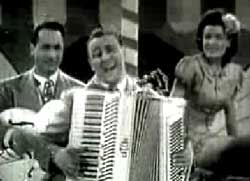 Caravan (1944) is a two minute soundie hardly worth the waste of film unless god help you you're a fan of accordion music. If you do suffer that affliction then the title song "Caravan" is the perfect piece of crud to enhance life.
Caravan (1944) is a two minute soundie hardly worth the waste of film unless god help you you're a fan of accordion music. If you do suffer that affliction then the title song "Caravan" is the perfect piece of crud to enhance life.
A group called the Three Suns includes an organist & guitarist backing up the accordionist, plus we get a mess of ladies sitting around to add decor. Allegedly this was Mamie Eisenhower's favorite group, she was mentally ill after all.
They are usually defined as Exotica jazz, but that assumes that grandma at her mini-hammond organ playing easy tunes has some relationship exotica. Their arranger was Charles Albertine, & with unified exertion they managed to produce one genuine hit instrumental, "Twilight Time," for which Buck Ram later added lyrics & sang it with his vocal group the Platters, charting at number one.
For the sake of the Platter's hit we might forgive The Three Sunst he rest of their miserable sound-alike records, but only barely. The trio's cover of Caravan is conceivably the worst ever version of any Duke Ellington composition. It was incorporated into the Official Films three-film home-movie rlease Musical Caravan (1947) together with two others numbers by the Three Suns' Tico Tico (1944), & My Heart Tells Me (1944).
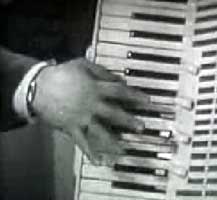 This last is a so-so song rendered unutterly milquetoast by Morty Nevin's organ & Artie Dunn's vocalization, with actresses Gloria Graham & Ann Parker appearing as decorations. This last is a so-so song rendered unutterly milquetoast by Morty Nevin's organ & Artie Dunn's vocalization, with actresses Gloria Graham & Ann Parker appearing as decorations.
The Three Suns soundies rarely have anything in them visually beyond the Lawrence Welkian performance, but this one actually cuts away to sundry pairs of actors & actresses playing lovers gazing into one another's adoring faces. The couples aren't especially interesting, but they're better than looking at the trio.
How cliche can choices get for the Three Suns? How about Tico Tico with organ & accordion trading off proving that no matter how bad you think they can be, they can be worse. And I really thought they'd let the guitarist have a real moment on this one, but no, he's just used in lieu of a drummer & never gets a solo.
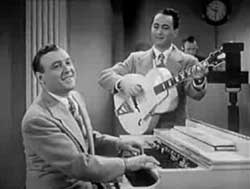 It might seem a soundie couldn't be worse than the three numbers on Musical Caravan: Soundies Musical Film Review but that alas was high-end for the Three Suns. It might seem a soundie couldn't be worse than the three numbers on Musical Caravan: Soundies Musical Film Review but that alas was high-end for the Three Suns.
Beyond the Blue Horizon (1944) at two minutes begins with an organ solo that sounds like the kind of organ music that used to be played in roller rinks, or which granny played at her tiny Hammond organ following the numbers printed on the keys.
Then the accordion enters the mix & it's kind of like leaping out of a cow pie into a sludgy pool of pig poo.
Halfway through the three-minute film, Artie Dunn on accordion begins to sing the lyrics, but that doesn't last long before it's back to the accordion & organ instrumental. That sad guitarist never seems to get a solo.
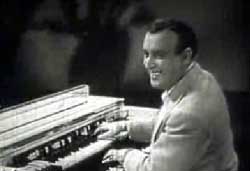 We may again experience the anti-bliss of the Three Suns in William Tell Overture (1944). We may again experience the anti-bliss of the Three Suns in William Tell Overture (1944).
The aggressively awful trio consists of the granny-style organist Morty Nevins ("Mort" meaning "Death," appropriate for this band), his brother strummer-guitarist Al Nevins, & Swedish nationalist parade accordionist Artie Dunn.
That their idea of really swinging is a rousing rendition of the "William Tell Overture" pretty much says it all.
It would've been a hoot if your little brother played it at the junior highschool concert, a moment in the spotlight before the normal kids stuffed him in his locker.
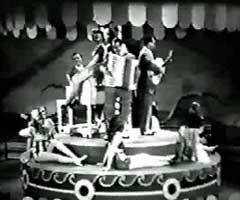 The most life this laughably hideous performance manages is when the accordionist begins gallopping in place in emulation of the Lone Ranger's horse Silver. The most life this laughably hideous performance manages is when the accordionist begins gallopping in place in emulation of the Lone Ranger's horse Silver.
Swinging the Classics with the Three Suns (1947) combined William Tell Orchestra with two other of the group's miserable soundies for release to the home-movies market.
Pause to think a moment how anyone could represent as "swing" a rousing accordian rendition of William Tell Overture, without meaning swinging from a branch until dead. Then swoon to the promise of further classics, The Anvil Chorus (1944) & Song of India (1944), given Uncle Torval's accordian & Grandma Piddypoo's organ treatment.
Song of India is a peg up from their other awful soundies, though still a peg lower than anything good. With more of a carnival atmosphere, Song of India shows the Three Suns underneath some used-car-lot flags, riding round & round on a wedding cake-shaped lazy susan. The same lazy susan was seen in Caravan only the hamster must've died because it wasn't spinning.
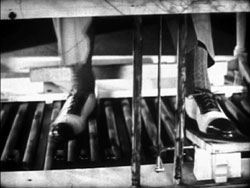 Two suzy-cuties are sitting on Mort's organ, so to speak, & several more cuties pose like bathing beauties below them on the spinning cake's lower layer. Two suzy-cuties are sitting on Mort's organ, so to speak, & several more cuties pose like bathing beauties below them on the spinning cake's lower layer.
Their performance is subdued perhaps because they're dizzy old coots afraid of falling off the cake.
For Anvil Chorus, the performance is dominated by the circusy organ. It squalls as bad as grandma at her play-by-numbers Hammond.
The most interesting part of the Artie's performance is the close-up of the foot petals, revealing his saddle-shoes.
Al, the guitarist, strums like a madman trying to get a big noise out of his big guitar, no finesse at all. Morty's corny all-white accordion makes squeeky sounds. They stand together on a tiny round stage amazing the viewer by their ability to get any gigs whatsoever.
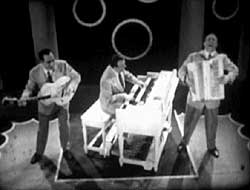 So as a generality The Three Suns were a mediocre pop group for old folks even when they were a "new" act, but for their soundie Stalingrad (1944) they add a new dimension to their act, vis, ridiculousness.
So as a generality The Three Suns were a mediocre pop group for old folks even when they were a "new" act, but for their soundie Stalingrad (1944) they add a new dimension to their act, vis, ridiculousness.
Out of some misguided attempt to make them seem arty, they're placed on a minimalist set in white suits & white instruments against black background so that they look like their placemat-stage is floating in space. There they drift with their king-size Hammond organ, accordion, guitar, & their "we just at poop" grins.
Add to this happy, bouncy, moronic instrumental the rather sick fact that The Three Suns recorded it for its timeliness in commemorating the Nazi siege of Stalingrad which took place from August 21, 1942 to February 2, 1943.
This was among the bloodiest events of WWII, during which the civilian casualties alone numbered some 40,000, with Red Army casualities exceeding a million, & over a million additionally wounded or captured -- without bothering to enumerate German casualities since they deserved it.
Surely that heroic resistance & mass slaughter required a circus tune for their commemoration, right?
copyright © by Paghat the Ratgirl
|
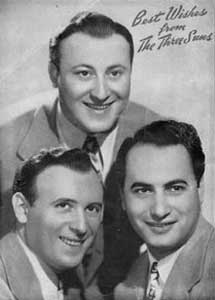

 This last is a so-so song rendered unutterly milquetoast by Morty Nevin's organ & Artie Dunn's vocalization, with actresses Gloria Graham & Ann Parker appearing as decorations.
This last is a so-so song rendered unutterly milquetoast by Morty Nevin's organ & Artie Dunn's vocalization, with actresses Gloria Graham & Ann Parker appearing as decorations. It might seem a soundie couldn't be worse than the three numbers on Musical Caravan: Soundies Musical Film Review but that alas was high-end for the Three Suns.
It might seem a soundie couldn't be worse than the three numbers on Musical Caravan: Soundies Musical Film Review but that alas was high-end for the Three Suns.
 The most life this laughably hideous performance manages is when the accordionist begins gallopping in place in emulation of the Lone Ranger's horse Silver.
The most life this laughably hideous performance manages is when the accordionist begins gallopping in place in emulation of the Lone Ranger's horse Silver. Two suzy-cuties are sitting on Mort's organ, so to speak, & several more cuties pose like bathing beauties below them on the spinning cake's lower layer.
Two suzy-cuties are sitting on Mort's organ, so to speak, & several more cuties pose like bathing beauties below them on the spinning cake's lower layer.